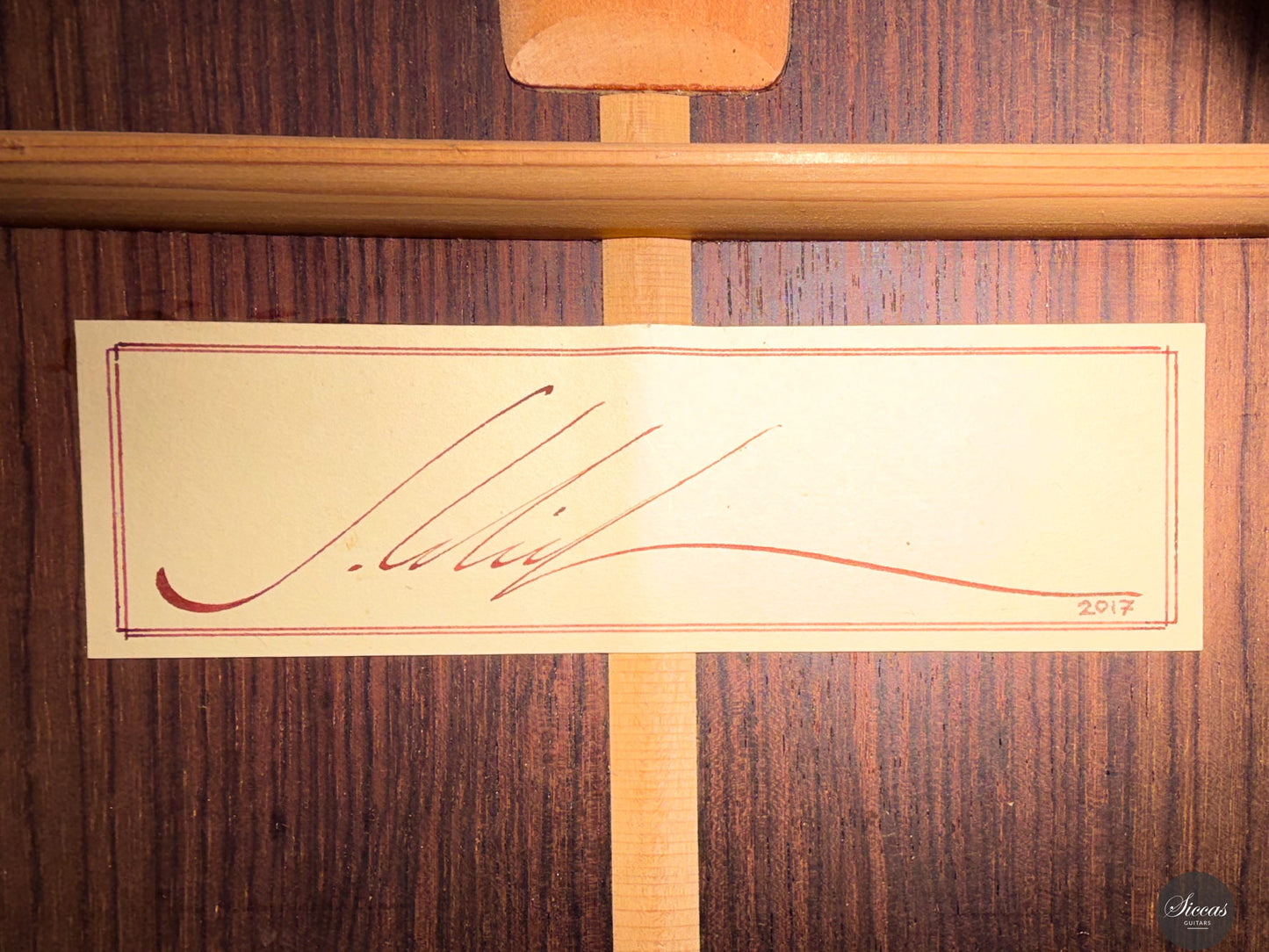Jakob Lebisch - 2017
Jakob Lebisch - 2017
Details
Details
Overview
Overview
Shipping important note
Shipping important note
Delivery times are typically reliable and most instruments arrive within the estimated timeframe.
Should any unexpected delay occur, our team will keep you informed and provide support at every step. For all shipping details and exceptions, please see our Shipping Policy.
Details about GPSR
Details about GPSR























Video overview


More details about the guitar
About the luthier
Jakob Lebisch works in Offenbach near Frankfurt and is regarded as one of the leading figures of the younger generation of double top builders. His background in fine craftsmanship and his focus on the acoustical behaviour of lightweight structures shaped his reputation very early in his career. Through steady refinement of his methods he created double top instruments that attracted international attention and set new standards for power and responsiveness. His guitars are admired for their clarity of concept and for a construction style that is both elegant and efficient.
Over the years he has developed a signature approach that blends structural minimalism with strong projection. His instruments often feature extremely low body weight combined with highly controllable resonance behaviour. Players appreciate his attention to detail which extends to preventive structural choices that enhance long term stability without adding unnecessary mass. Many concert guitarists value the direct tactile feedback of his instruments and the way the tone stays open even under strong articulation.
About the guitar
This double top guitar from 2017 reflects the qualities for which Jakob Lebisch is so well known. The cedar soundboard works together with the internal core to create a very fast and highly reactive surface. The body of Indian rosewood is finished with French polish and the entire instrument remains remarkably light in the hands. The air body resonance lies around E which gives the guitar a naturally open and clear presencem with deep basses and well-supported trebles. Klaus Scheller tuning machines support precise and stable tuning.
The sound shows the extraordinary energy and immediacy often associated with Lebisch guitars. The response is almost instantaneous. Tones leave the soundbox with a sense of pure force yet they keep a graceful beauty in their colour. Projection is impressive for such a lightweight build. The guitar throws its voice easily into the room and remains balanced while doing so. Even under demanding articulation the clarity between registers stays intact and every tone seems to cut through with conviction. It is easy to understand why so many professional players seek out his instruments. The combination of speed openness and power makes this guitar feel ready for any concert situation.
Condition
The instrument is in excellent condition with no cracks or repairs. It shows only normal signs of careful use and remains structurally clean and fully stable.
Regular care extends the life of the instrument
Even with careful use, a classical guitar may gradually change in appearance or respond to unstable storage conditions. Have a close look at your guitar regularly and be attentif to changes. If your instrument is suffering from its environement, it will let you know.
Protect Your Guitar: Handle with Care
Be mindful when touching your instrument with greasy or unwashed hands: any skin contact is a small attack on the varnish. Of course, a guitar is made to be played, but taking a few precautions helps preserve its beauty: wash your hands before playing, wear long sleeves, and avoid unnecessary direct skin contact with the body of the instrument.
Pro tip: Avoid playing with a button-up shirt, heavy jewelry, or a belt, as these can scratch the guitar. Also, make sure your guitar case is free of any objects that could damage the instrument during storage.
String care
A good habit to adopt is wiping down your strings briefly after each playing session. This small action significantly extends their lifespan and helps maintain a consistent, comfortable feel under your fingers.
Most importantly, clean strings are essential for keeping your instrument in tune. Corrosion, sweat, and dust can affect the uniformity of the strings and interfere with accurate tuning across the entire fingerboard.
Pro tip: If you're having trouble getting your guitar in tune, it might be time to change the strings. A useful test is to compare the pitch of the 12th fret harmonic with the fretted note at the 12th fret; if there's an unusually large gap between them, your strings may have lost their integrity and should be replaced.
Keep Your Shellac Finish Shining!
Got a guitar with a shellac (French polish) finish? Here's a simple trick: Take a clean microfiber cloth and gently breathe on the surface to create a light mist. Then, softly rub to remove fingerprints, sweat, and grease. That’s usually all it takes to keep it looking great, no products needed!
Pro tip: Every few years, treat your guitar to a check-up with a luthier to keep it in top shape.
Storing Your Guitar: Climate Matters
Your guitar can safely stay outside its case, as long as the surrounding environment maintains 42–55% humidity and a temperature between 18–25°C.
Keep in mind that humidity levels can still fluctuate inside the case, especially during seasonal changes.
- Too much humidity may cause overtightened strings and a dull tone.
- Too little humidity can lead to a bulging top, string buzz, or even cracks.
Avoid placing your guitar near radiators, air conditioners, or windows with direct sunlight.
Pro tip: Always close your guitar case while playing. This helps preserve a stable microclimate inside the case, so your instrument is protected the moment you put it back in.



















































